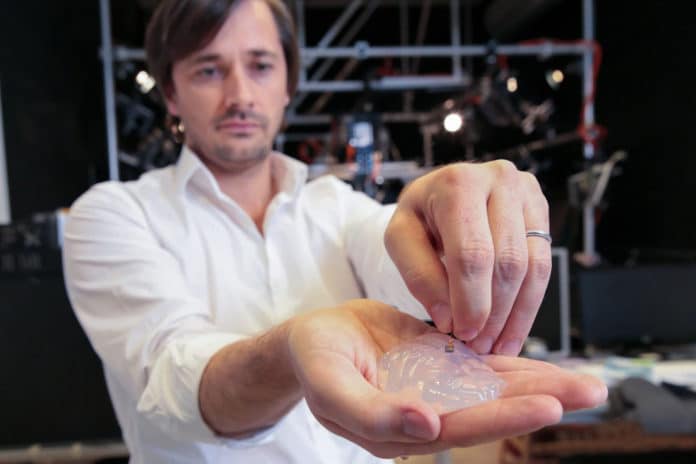Scientists have developed a set of wireless brain and spinal cord implants that helped monkeys with severed spinal cords regain control over their paralyzed limbs and walk again.
The device, reported Wednesday in the journal Nature, is the first to give a paralyzed primate the ability to control its limbs with its brain.
“We’re actually taking brain signals and putting them back into the nervous system at the spinal cord level to activate locomotion,” said David Borton, a neuroengineer at Brown University and co-author of the study. “That hasn’t been done before.”
The achievement is the latest in a series of rapid advances in the field of neuroprosthetics, with engineers and neuroscientists using tiny implants to decode signals from the brain and relay them to other parts of the body.
Earlier this year, researchers at the University of Pittsburgh and the University of Pittsburgh Medical Center demonstrated that an electrode smaller than a grain of sand could be implanted in the brain of a paralyzed man to allow him to experience the sense of touch with a mind-controlled robotic arm. Another project restored a quadriplegic man’s control over his via a brain implant and electronic sleeve.
But neither of those studies involved a wireless device – something that will be essential if scientists hope to help paralyzed humans walk again, according to co-author Grégoire Courtine, a neuroscientist at the Swiss Federal Institute of Technology.
“The monkeys can just walk around freely,” he said.
One half of the device is a small electrode, no larger than the tip of a pinkie finger, that was inserted into the motor center of each monkey’s brain. The electrode picked up signals related to leg motion and beamed the patterns to a nearby computer, which interpreted what they meant.
Each of these steps represented a scientific breakthrough: Researchers had to develop an implant capable of tracing signals through the brain at the neural level. The implant needed to be able to communicate wirelessly with a computer outside the body. And the computer required software that understood what each electrical signal meant – stop, go, bend knee, plant foot, tilt forward, etc.
The computer then relayed its interpretation of the signal to a second implant located along the monkey’s spinal cord below the injury site. Before the implant, this part of the nervous system was cut off from the brain. The circuits were silent. Each monkey was unable to move one of its hind legs.
But Courtine and his colleagues engineered the implant to stimulate the spinal cord according to one of two patterns dictated by the monkey’s own brain. One pattern of electric pulses would instigate the “swing” phase of locomotion, the other prompted the “stance” phase.
The series of signals, when applied correctly, tapped into spinal cord circuits related to locomotion that had previously been dormant. From there, the signal traveled to muscles in the monkey’s paralyzed leg, moving it as though the message had come directly from the monkey’s brain.
The primate’s gait was not quite normal, and this technology is still a long way from being implemented in people. If and when it does become available for human patients, it’s unlikely that it will completely restore lost abilities. The goal is to improve rehabilitation by strengthening neural circuits on both sides of the injury.
” Neurons that fire together tend to wire together,” Borton said. “If we think about the possibilities for rehabilitation, one of the big goals for this project is to leverage the intrinsic learning capabilities of the body to help strengthen remaining connections that may be in the spinal cord even after an injury.”
Courtine has previously used neuroprosthetics to restore the ability to walk, run and navigate stairs in lab rats. This experiment was performed on two rhesus monkeys that had one of their legs paralyzed by a surgery that partially transected their spinal cords.
Such animal research is controversial, but Borton said it’s essential to test these tools on primates – whose sophisticated nervous systems are much closer to ours than rats’ systems are – if scientists ever want to apply them to humans.
Chad Bouton, director of the Center for Bioelectronic Medicine at Feinstein Institute in New York, called the study “an important step forward for neuroprosthetics – no pun intended.”
“It does continue to show that this idea of rerouting signals from the brain to paralyzed muscles is very promising for treating paralysis and neurological injuries,” said Bouton, the lead author of an April study on the project that used an implant and electronic sleeve to give a quadriplegic man control of his hand.
In contrast with that experiment, which used brain signals to directly stimulate the muscles of the hand, the authors of the Nature study opted to direct motion via the spinal cord, Bouton noted. They were able to do this because they had recorded the spinal cord’s stimulation patterns related to locomotion before performing the surgery that would paralyze the monkeys. This was helpful for lab research, he said, but it wouldn’t be feasible when treating a human patient.
Borton acknowledged that this technology still has a long way to go. When asked how long before it might help a human walk again, he declined to even speculate – that’s just asking to be proven wrong, he said.
But he thinks researchers are on the right track. Watching the video of the monkey taking its first steps “is powerful from a very internal part of our bodies,” he said. “To see something move that didn’t move before.”
—
Video: Brain implant helps paralyzed monkeys regain the ability to walk
URL: http://wapo.st/2fEjfLK






